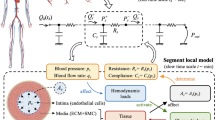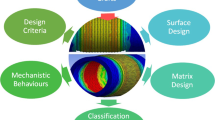Abstract
The ultimate goal of the present work is to aid in the development of tools to assist in the treatment of cardiovascular disease. Gaining an understanding of hemodynamic parameters for medical implants allow clinicians to have some patient-specific proposals for intervention planning. In the present work an experimental and digital computational fluid dynamics (CFD) arterial model consisting of a number of major arteries (aorta, carotid bifurcation, cranial, femoral, jejunal, and subclavian arteries) were fabricated to study: (1) the effects of local hemodynamics (flow parameters) on global hemodynamics (2) the effects of transition from bedrest to upright position (postural change) on hemodynamics, and (3) diffusion of dye (medical drug diffusion simulation) in the arterial system via experimental and numerical techniques. The experimental and digital arterial models used in the present study are the first 3-D systems reported in literature to incorporate the major arterial vessels that deliver blood from the heart to the cranial and femoral arteries. These models are also the first reported in literature to be used for flow parameter assessment via medical drug delivery and orthostatic postural change studies. The present work addresses the design of the experimental and digital arterial model in addition to the design of measuring tools used to measure hemodynamic parameters. The experimental and digital arterial model analyzed in the present study was developed from patient specific computed tomography angiography (CTA) scans and simplified geometric data. Segments such as the aorta (ascending and descending) and carotid bifurcation arteries of the experimental and digital arterial model was created from online available patient-specific CTA scan data provided by Charite’ Clinical and Research Hospital. The cranial and coronary arteries were simplified arterial geometries developed from dimensional specification data used in previous work. For the patient specific geometries, a MATLAB code was written to upload the CTA scans of each artery, calculate the centroids, and produce surface splines at each discrete cross section along the lumen centerline to create the patient specific arterial geometries. The MATLAB code worked in conjunction with computer aided software (CAD) Solidworks to produce solid models of the patient specific geometries and united them with the simplified geometries to produce the full arterial model (CAD model). The CAD model was also used as a blueprint to fabricate the experimental model which was used for flow visualization via particle imaging velocimetry (PIV) and postural change studies. A custom pulse duplicator (pulsatile pump) was also designed and developed for the present work. The pulse duplicator is capable of producing patient-specific volumetric waveforms for inlet flow to the experimental arterial model. A simple fluid structure interaction (FSI) study was also conducted via optical techniques to establish the magnitude of vessel diameter change due to the pulsatile flow. A medical drug delivery (dye dispersion and tracing) case was simulated via a dye being dispersed into the pulsatile flow stream to measure the transit time of the dye front. Pressure waveforms for diseased cases (hypertension & stenotic cases) were also obtained from the experimental arterial model during postural changes from bedrest (0°) to upright position (90°). The postural changes were simulated via attaching the experimental model to a tile table the can transition from 0° to 90°. The PIV results obtained from the experimental model provided parametric data such as velocity and wall shear stress data. The medical drug delivery simulations (experimental and numerical) studies produce time dependent data which is useful for predicting flow trajectory and transit time of medical drug dispersion. In the case of postural change studies, pressure waveforms were obtained from the common carotid artery and the femoral sections to yield pressure difference data useful for orthostatic hypotension analysis. Flow parametric data such as vorticity (flow reversal), wall shear stress, normal stress, and medical drug transit data was also obtained from the digital arterial model CFD simulations. Although the present work is preliminary work, the experimental and digital models proves to be useful in providing flow parametric data of interest such as: (1) normal stress which is useful for predicting the magnitude of forces which could promote arterial rupture or dislodging of medical implants, (2) wall shear stress which is useful for analyzing the magnitude of drug transport at the arterial wall, (3) vorticity which is useful for predicting the magnitude of flow reversal, and (4) arterial compliance in the case of the experimental model which could be useful in the efforts of developing FSI numerical simulations that incorporates compliance which realistically models the flow in the arterial system.






























Similar content being viewed by others
References
Arnold, A., C. Battista, et al. Uncertainty quantification in a patient-specific one-dimensional arterial network model: EnKF-based inflow estimator. ASME J. Verif. Valid. Uncert. 2(1):14, 2017.
Avari, H., E. Savory, and K. A. Rogers. An in vitro hemodynamic flow system to study the effects of quantified shear stresses on endothelial cells. J. Cardiovasc. Eng. Technol. 7(1):44–57, 2015.
Beier, S., J. Ormiston, et al. coronary artery bifurcation haemodynamics-comparison between phase contrast MRI and Computational fluid dynamics. J. Cardiovsc. Magn. Resonan. 16(Suppl 1):224, 2014.
Boutsianis, E., M. Guala, U. Olgac, et al. CFD and PTV steady flow investigation in an anatomically accurate abdominal aortic aneurysm. J. Biomech. Eng. 131(1):011008, 2008.
Boyd, J., J. M. Buick, and S. Green. Comparison of Newtonian and non-newtonian oscillatory flows using the lattice boltzmann method. In: World Congress on Medical Physics and Biomedical Engineering, edited by R. Magjarevic, and J. H. Nagel. Berlin.: Springer, 2006, pp. 3395–3399.
Canic, S., and E. Kim. Mathematical analysis of the quasilinear effects in a hyperbolic model blood flow through compliant axisymmetric vessels. Math. Methods Appl. Sci. 26:1161–1186, 2003.
Castillo, F., L. Cymberknop, and M. Alfonso. Evaluation of the impact of arterial wall viscosity in pressure morphology by means of a simplified 1D model. In: Engineering in Medicine and Biology Society (EMBC), 2016 IEEE 38th Annutal International Conference, 2016.
Chaichana, T., Z. Sun, and J. Jewkes. Computational fluid dynamic analysis of the effect of plaques in the left coronary artery. Comput. Math. Methods Med. 2012:12, 2011.
Charite. Charite’ hospital teaching and learning. Obtained from: https://www.charite.de/en/. 2011.
Chein, S. Mechanotransduction and endothelial cell homeostasis: the wisdom of the cell. Am. J. Physiol. Heart Circ. Physiol. 292:H1209–H1224, 2007.
Davydov, D., and R. Czabak-Garbacz. Orthostatic cardiovascular profile of subjective well-being. Biol. Psychol. 123:74–82, 2017.
Ferranti, F., V. Tamburrelli, and G. Antonini. Rational macromodeling of 1D blood flow in the human cardiovascular system. Numer. Methods Biomed. Eng. 31(3):12, 2015.
Fox, R., A. McDonald, and P. Pritchard. Introduction to Fluid Mechanics (6th ed.). Hoboken: Wiley, 2004.
Ge, C., J. Song, et al. Atheroprotective pulsatile flow induces ubiquitin-proteasome-mediated degradation of programmed cell death 4 in endothelial cells. PLoS ONE 9(3):915, 2014.
Gharahi, H., B. Zambrano, D. Zhu, J. DeMarco, and S. Baek. Computational fluid dynamic simulation of human carotid artery bifurcation based on anatomy and volumetric blood flow rate measured with magnetic resonance imaging. Int. J. Adv. Eng. Sci. Appl. Math. 8(1):40–60, 2016.
Hewlin, R. Transient Cardiovascular Hemodynamics in a Patient-Specific Arterial System. New York: ProQuest Dissertations Publishing, 2015.
Hewlin, R., and J. Kizito. Comparison of carotid bifurcation hemodynamics in patient-specific geometries at rest and during exercise. ASME Fluids Eng. Div. Summer Meet. 82:74, 2013.
Kefayati, S., J. Milner, D. Holdsworth, and T. Poepping. In vitro shear stress measurements using particle imaging velocimetry in a familty of carotid artey models: effect of stenosis severity, plaque eccentricity, and ulceration. PLoS ONE 9(7):e98209, 2014.
Kheyfest, V., L. Rios, et al. Patient-specific computational modeling of blood flow in the pulmonary arterial circulation. Comput. Methods Programs Biomed. 120(2):88–101, 2015.
LaDisa, J., L. Olson, and R. Molthen. Alterations in wall shear stress predict sites on neointimal hyperplasia after stent implantation in rabbit iliac arteries. Am. J. Physiol. Heart Circ. Physiol. 288:H2465–H2475, 2005.
Li, A., et al. Serum low-density lipoprotein levels correlate with survival in advanced stage epithelial ovarian cancers. Gynecol. Oncol. 116(1):78–81, 2015.
Morris, P., A. Narracott, et al. Computational fluid dynamics modelling in cardiovascular medicine. BMJ Heart 102:18–28, 2015.
Muller, L., P. Blanco, S. Watanabe, and R. A. Feijoo. A higher-order local time stepping finite volume solver for one-dimensional blood flow simulations: application to the ADAN model. Numer. Methods Biomed. Eng. 32(10):12, 2016.
Parker, K., and C. Jones. Forward and backward running waves in the arteries: analysis using the method of characteristics. J. Biomech. Eng. 112:322–326, 1990.
Paszkowiak, J., and A. Dardik. Arterial wall shear stress: observations from the bench to bedside. Sage J. 37(1):47–57, 2003.
Pontrelli, G., and E. Rossoni. Numerical modelling of the pressure wave propagation in the arterial flow. Int. J. Numer. Methods Fluids 43:651–671, 2003.
Rojczyk, M. CFD Analysis of Blood Flow Within Aorta of Patient With Coarctation of Aorta. Stud. Inf. 37(125):43–55, 2016.
Shi, Y., P. Lawford, and R. Hose. Review of zero-D and 1-D models of blood flow in the cardiovascular system. Biomed. Eng. Online 10:33, 2011.
Smith, N., A. Pullan, and P. Hunter. An anatomically based model of transient coronary blood flow in the heart. SIAM J. Appl. Math. 62:990–1018, 2002.
Trachet, B., J. Bols, D. Gianluca, et al. The impact of simplified boundary conditions and aortic arch inclusion on CFD simulations in the mouse aorta: a comparison with mouse-specific reference data. J. Biomech. Eng. 133(12):121006, 2011.
Wentzel, J., R. Corti, F. Zahi, et al. Does shear stress modulate both plaque progression and regression in the thoracic aorta?: Human study using serial magnetic resonance imaging. J. Am. Coll. Cardiol. 45(6):846–854, 2005.
Zhang, Z., L. Yuan, P. Lee, et al. Modeling of time dependent localized flow shear stress and its impact on cellular growth within additive manufactured titanium implants. J. Biomed. Mater. Res. B Appl. Biomater. 102(8):1689–1699, 2014.
Zhao, H., G. Hongyu, L. Xiaopeng, L. Ding, and H. Qiao. The effect of different protection level on pilot’s respiratory and cardiovascular system. In: Advances in Ergonomics Modeling, Usability and Special Populations, Vol. 486, edited by M. Soares, C. Falcão, and T. Z. Ahram. New York: Springer, 2017, pp. 575–582.
Acknowledgment
The authors would like to acknowledge both companies United Biologics and BDC Labs for fabricating specialized models and tools used in the present work. United Biologics produced the physical model of the experimental arterial model from data supplied by the authors. BDC labs fabricated the custom pulse duplicator used in the present study.
Funding
This work was funded by the U.S. Department of Education HBGI Title III grant through North Carolina A&T State University.
Conflict of interest
The first author, Rodward Hewlin received a Title III HBGI Ph.D. fellowship from the US Department of Education through North Carolina A&T State University which not only funded the Ph.D. candidate, but this research as well. Both authors of this work declares that neither has no conflict of interest.
Human studies/informed consent
No human studies were carried out by the authors for this article.
Ethical approval
This article does not contain any studies with animals performed by any of the authors.
Author information
Authors and Affiliations
Corresponding author
Additional information
Associate Editor Hwa Liang Leo and Ajit P. Yoganathan oversaw the review of this article.
Electronic supplementary material
Below is the link to the electronic supplementary material.
Rights and permissions
About this article
Cite this article
Hewlin, R.L., Kizito, J.P. Development of an Experimental and Digital Cardiovascular Arterial Model for Transient Hemodynamic and Postural Change Studies: “A Preliminary Framework Analysis”. Cardiovasc Eng Tech 9, 1–31 (2018). https://doi.org/10.1007/s13239-017-0332-z
Received:
Accepted:
Published:
Issue Date:
DOI: https://doi.org/10.1007/s13239-017-0332-z




